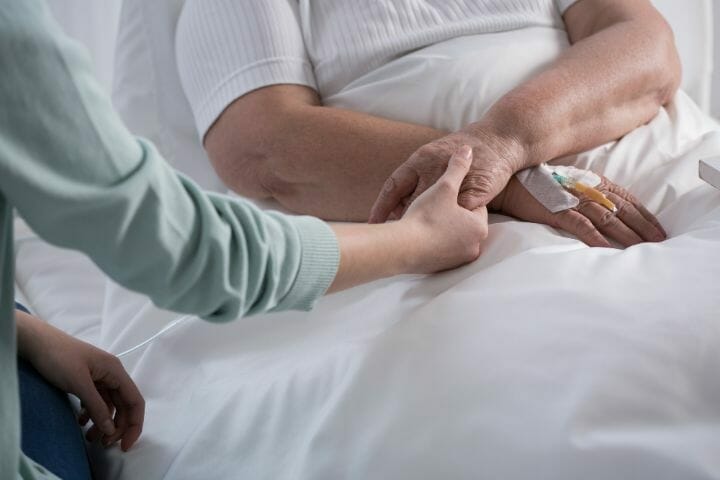Palliative care for the elderly is a patient-oriented approach to improve the quality of life of patients with serious illnesses. It helps in relieving and preventing suffering your suffering by right assessment, early identification, and treatment of spiritual, psychosocial, and physical problems.
This Palliative care is provided with the collaboration of physicians, caregivers, nurses, and other allied healthcare providers who might be important in order to maintain a person’s functionality.
Palliative care is not about the prognosis of the patient but is basing on the patient’s needs. This care appropriate at any stage and at any age when you experience a serious illness and this can be given to you alongside the curative treatment.
Do not be confused with a hospice. Both can provide care and comfort for the patient, but the difference is whether it is terminal, or a life-long condition to be dealt with.
People only enter the hospice whenever they have 6 months or less to survive. There is an overall involvement of not only the medical team but also the family, and social workers.
Why do some seniors need palliative care?
For the sole purpose to improve the quality of life of someone in the final stages of their life. Integrating their psychosocial, physical, and spiritual needs are the keys to successful palliative care. Palliative care is patient-centered, to which their needs are important before tending to their health conditions.
The other important components of palliative care are effective communication and planning and coordination of care. You can introduce Palliative care in various ways-home care, community-based, and hospice. And it only depends on how their needs are met, although you can consider: is home health care better or being in a nursing home is an option.
The management of symptoms is taken care of. Mostly, patients under palliative care are managed from symptoms of pain, shortness of breathing, anxiety, depression, fatigue, and nausea. By identifying these problems, and what might have caused them, interventions are made for either relief, treatment, first-aid, or cure.
Not only that, but health professionals who deal with palliative care also engage in preventive care. Medications are provided to patients, to either subside or eliminate factors that hinder their quality of life. For example, people with chronic constipation, or who have high chances to develop it, are provided with laxatives.
You may also like How to Find a Good Caregiver for Elderly
Here is an introduction to palliative care for the elderly and their families.
Benefits of Palliative Care for the Elderly
According to the Cancer Network, there are significant benefits of palliative care:
1. Improvement communications between patients, caregivers, and healthcare providers
This can assure that the patient under the care is taken care of in all aspects involved. It will be easier to provide information, convey evaluations, and communicate concerns if any changes, improvement or decline occurs with the individual.
2. Addresses the needs of caregivers as they cope with care for a loved one with a serious illness
To address the needs of the caregivers will differ and vary over time. Coping with a loved one with a serious illness is tough especially if they are family members. Or close tied friends, the company at home. Their involvement is necessary for a better result/improvement.
3. Offer psychological and spiritual care
As part of the multidisciplinary approach of palliative care, it is important to check in with patients. Especially if they are suffering from anxiety or depression. Moreover, palliative care through psychological interventions can help them cope as themselves with their diseases/disorders.
4. Develops a support system to help the patient live as actively as possible
Part of having a good quality of life is to have social connections. Involving the individual in activities, decision making, discussions of day-to-day, and informing them about their status will keep them updated, and engaged.
You may also like How to Care for a Bedridden Elderly Person?
5. Improves patient and family satisfaction with care
With the involvement of every caregiver, healthcare provider, and physician, reported satisfaction can be anticipated. By ensuring the wellbeing of the individual in care, it will provide confidence and assurance to their families that they are not detached, and apart from living their normal life.
6. Improves quality of care while reducing costs
There are healthcare insurances that provide palliative care as a category wherein multidisciplinary involvement costs lesser than intermittent doctor visits, and unexpected occurrences of emergency visits. Reduced costs come from the ability to monitor the patient continuously.
7. Enables patients to remain comfortable by preventing and relieving pain and suffering
Similar to having patient and family satisfaction, increased confidence or assurance is ensured when palliative care is provided and can meet the demands, and complaints of the patient. Therefore, they won’t get frazzled with any problems that arise with their condition.
You may also like Best Heavy Duty Disposable and Washable Bed Pads
8. Allow patients to maintain connections to family members and friends
Depending on where the palliative care is provided, individuals are encouraged and engaged to keep their communications to their loved ones. If their needs and demands are met, they will be able to join their family or friends in whatever activity they wish to do.
9. Foster vitality and independence in patients
Reassurance to the patient that their conditions are manageable can uplift the patient. Their energies are renewed, and the culminated support from their family, confidence, and assurance in care are factors that can give them a sense of independence and vitality.
10. Assists with navigating the healthcare system, including putting together an advance directive
Being in palliative care can benefit you with access to the care needed faster than being in a doctor’s visit, or in an emergency situation. Healthcare providers connected to institutions, or clinics can provide you connections on what will be necessary for the patient.
You may also like How to Bathe an Elderly Person in Bed?
Stages of Palliative Care
According to the Australian Institute of Health and Welfare; terminal, deteriorating, unstable, and stable are 4 palliative care phases.
Whenever assigned for care, the three stages are usually anticipated. And it will reflect of the effectiveness of the plan of care provided by every provider.
Stable – controlled existing problems, and can plan further of the interventions to maintain function and quality of life. No new apparent issues arose, and the family/career situation is controlled. The plan of care is established, and monitoring continues.
Unstable – the problems arise and increasing in severity. These problems may or may not be anticipated in the plan of care. Circumstances like this impact the family, career, and life of everyone involved. The care plans shall be reviewed periodically in order to anticipate anything not normal. An emergency visit is possible.
Deteriorating – the overall status of the patient is declining. The symptoms will worsen over time. New but anticipated problems also develop. Distress in family and carers are also reported. Alike of being unstable, care plans shall be assessed periodically, and the patient is evaluated to see whether they can recover or not.
Terminal – The terminal phase is referred to a hospice or depending on the family/patient’s choice. This is when it is inevitable, and arrangements are made from the anticipated passing of the individual. Nonetheless, this stage is imminent but also attempted to not reach. Bereavement is the additional stage when the patient has already died.
You may also like Do the Elderly Know When They Are Dying?
What Can I Expect From Palliative Care?
Upon evaluation by your physician, the individual will be consulted about their life and needs. The family will also be asked.
Whether they agree to participate in the overall success of care. They will be able to factor in your medical condition, medications needed, and any interventions that will help you through the process.
Then, you will be referred to your primary care team. Your primary care team can include the following: a physician on call, a nurse (whether staff, licensed vocational, or registered), social worker, chaplain, psychiatrist, counselors, and sometimes, physical and occupational therapists. They will be the ones to provide the intended needs to be met.
You will be communicating, and coordinating with them for a long time.
Usually, they are present to manage the symptoms you experience firsthand (symptoms management). Visitations are frequent, and they tend to your needs and demands of every day.
They can also provide support and advice with any questions you are concerned with. Because chronic conditions are usually hard to deal with. They never are resolved fully.
The involvement of your family plays a role in how do they deal with the stress, health concerns, psychological changes, and financial concerns as well.
These are all documented by the care provider and reported back to the physician. To which can be conveyed to all other involved parties, to be informed, and educated. Also to provide solutions for it.
Under palliative care, you’ll be given instructions in order to make it easier. You will be taught techniques like breathing techniques, meditation, doing activities in parts, and even listening to music to help you heal. It can also give you a sense of normalcy and regulate yourself to what you’re capable of.
Things To Note
Not every country provides palliative care, but these are covered in healthcare insurances for several countries like the United States, Australia, New Zealand, and those with public healthcare. Still, it is a subject by the WHO to further evaluate whether it shall be a universal norm not only for the elderly but also for people with chronic disorders.




